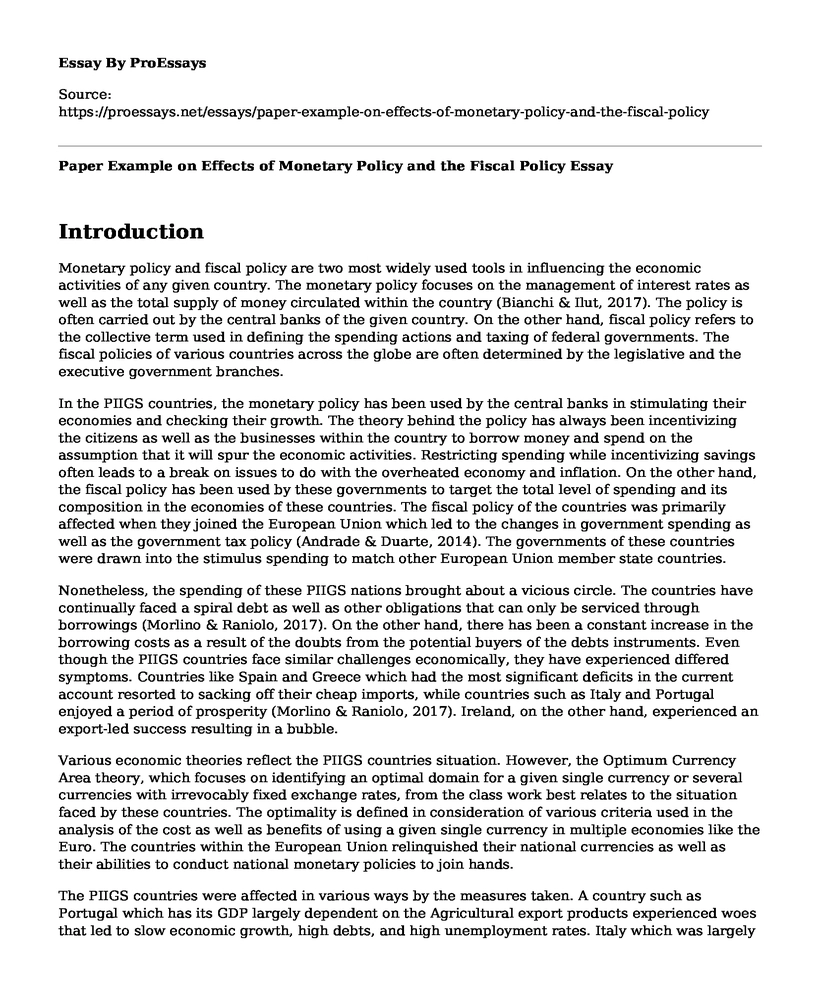Introduction
Monetary policy and fiscal policy are two most widely used tools in influencing the economic activities of any given country. The monetary policy focuses on the management of interest rates as well as the total supply of money circulated within the country (Bianchi & Ilut, 2017). The policy is often carried out by the central banks of the given country. On the other hand, fiscal policy refers to the collective term used in defining the spending actions and taxing of federal governments. The fiscal policies of various countries across the globe are often determined by the legislative and the executive government branches.
In the PIIGS countries, the monetary policy has been used by the central banks in stimulating their economies and checking their growth. The theory behind the policy has always been incentivizing the citizens as well as the businesses within the country to borrow money and spend on the assumption that it will spur the economic activities. Restricting spending while incentivizing savings often leads to a break on issues to do with the overheated economy and inflation. On the other hand, the fiscal policy has been used by these governments to target the total level of spending and its composition in the economies of these countries. The fiscal policy of the countries was primarily affected when they joined the European Union which led to the changes in government spending as well as the government tax policy (Andrade & Duarte, 2014). The governments of these countries were drawn into the stimulus spending to match other European Union member state countries.
Nonetheless, the spending of these PIIGS nations brought about a vicious circle. The countries have continually faced a spiral debt as well as other obligations that can only be serviced through borrowings (Morlino & Raniolo, 2017). On the other hand, there has been a constant increase in the borrowing costs as a result of the doubts from the potential buyers of the debts instruments. Even though the PIIGS countries face similar challenges economically, they have experienced differed symptoms. Countries like Spain and Greece which had the most significant deficits in the current account resorted to sacking off their cheap imports, while countries such as Italy and Portugal enjoyed a period of prosperity (Morlino & Raniolo, 2017). Ireland, on the other hand, experienced an export-led success resulting in a bubble.
Various economic theories reflect the PIIGS countries situation. However, the Optimum Currency Area theory, which focuses on identifying an optimal domain for a given single currency or several currencies with irrevocably fixed exchange rates, from the class work best relates to the situation faced by these countries. The optimality is defined in consideration of various criteria used in the analysis of the cost as well as benefits of using a given single currency in multiple economies like the Euro. The countries within the European Union relinquished their national currencies as well as their abilities to conduct national monetary policies to join hands.
The PIIGS countries were affected in various ways by the measures taken. A country such as Portugal which has its GDP largely dependent on the Agricultural export products experienced woes that led to slow economic growth, high debts, and high unemployment rates. Italy which was largely driven by tourism experienced negative effects since the stumbling of the world economy. The country also experienced low property rights protection, bureaucracy, high taxation, and high corruption levels greatly affecting their GDP (Morlino & Raniolo, 2017). The GDP of these countries were also affected by non-bank financial corporations, households, as well as nonprofit institutions.
References
Andrade, J. S., & Duarte, A. P. (2014). Output-gaps in the PIIGS Economies: An Ingredient of a Greek Tragedy. International Journal of Academic Research in Economics and Management Sciences, 3(1), 159.
Bianchi, F., & Ilut, C. (2017). Monetary/fiscal policy mix and agents' beliefs. Review of Economic Dynamics, 26, 113-139.
Morlino, L., & Raniolo, F. (2017). The impact of the economic crisis on South European democracies. Springer.
Cite this page
Paper Example on Effects of Monetary Policy and the Fiscal Policy. (2022, May 23). Retrieved from https://proessays.net/essays/paper-example-on-effects-of-monetary-policy-and-the-fiscal-policy
If you are the original author of this essay and no longer wish to have it published on the ProEssays website, please click below to request its removal:
- Research Paper Example: The Use of Drones in the Auditing and Accounting Profession
- Essay Sample on Investment in the Internet of Things
- Understanding & Managing Financial Risk in Business: Currency, Liquidity & Interest Rate
- Paper Example on Funding Education: A Cost-Benefit Analysis
- Essay Example on Amazon Stock: Rapid Increase Amidst Covid-19
- Unlocking the Potential of Technology Scanning: A Strategic Investment for Business - Essay sample
- Healthcare for Undocumented Immigrants- Report Sample







